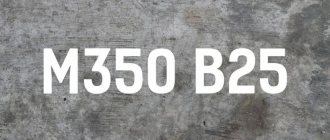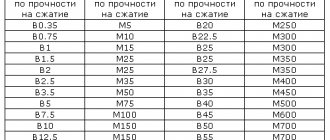One of the most serious problems in modern construction lies in the formal approach to assessing the strength characteristics of concrete structures during construction and operation. It is generally accepted that concrete has a homogeneous structure. In fact, it contains not only heterogeneity in composition, but also many surface and internal spatial defects that can significantly reduce the service life of a building or structure. To determine the strength of concrete structures, various methods of destructive and non-destructive testing are used. One of them is the ultrasonic non-destructive testing method. Due to its versatility, this method is used to assess the strength characteristics of concrete on construction sites at all stages of material strength development, as well as during the operation of the facility.
Determining the strength of concrete using the ultrasonic method is one of the profile methods. Using advanced equipment, qualified employees of the testing laboratory will check the structures for compliance with the physical and mechanical characteristics of the current GOST and TU. Based on the test results, the customer receives a conclusion in the established form.
| Determination of the strength of concrete in structures using the ultrasonic method according to GOST 17624-2012 (one section). | From 450 rub. |
See all prices
Make an order
Essence of the method
Ultrasound testing of concrete falls into the category of non-destructive indirect testing methods. It can be carried out at any facility and does not require its decommissioning. The difference between indirect methods and direct ones is that during the measurement process it is not strength that is recorded, but measurements of the time and speed of propagation of ultrasound, on which the result of the strength characteristics and compliance with the design class of concrete depends.
During ultrasound examination, the time or speed of passage of a wave is measured during superficial or through sounding. These indicators are correlated with strength. The peculiarity of this dependence is that the same value of the recorded indicator can correspond to different values of the desired value. That is, the correlation between the speed of the wave and the passage of the wave also depends on other parameters: the type and brand of cement, the size and type of aggregate, humidity, hardening conditions, temperature at the time of measurements, carbonization and others.
To obtain the strength of concrete, it is necessary to construct a calibration relationship between the characteristics of ultrasound (indirect method) and the strength of concrete determined by the direct method. To do this, measurement is performed using one of the following methods based on a direct relationship:
- When conducting tests to determine the strength of concrete, for example, immediately after formwork, the strength of prepared samples is tested, which are pre-made from the concrete mixture used for pouring. Standard-shaped samples (cubes, less often cylinders) 28 days old are loaded in a press with a constant rate of force increase until complete destruction.
- When studying objects that are in operation, with an unknown composition of concrete, measurements are performed using the peeling method. A hole is drilled in the structure, an anchor is screwed in and pulled out with a special device that records the force. For densely reinforced or thin-walled structures, other methods of local destruction are used: chipping ribs or tearing off disks.
The device for testing the strength of concrete structures using ultrasound includes the following main elements:
- Signal generator – generates electrical impulses of a certain frequency;
- probe-emitter – converts pulses into mechanical vibrations;
- The receiver probe records the ultrasound that has passed through the concrete and converts it back into electrical impulses.
The device records the travel time of the wave and calculates its speed. The readings are converted into digital form and remain in memory.
There are two techniques for conducting ultrasound examinations:
- Superficial sound. The signal source and receiver are located on the same surface. This method allows you to evaluate the strength at a shallow depth. The receiver registers the reflected signal. The technique is used in the study of thin-walled or hollow concrete products.
- Through sound. The probes are located on opposite surfaces of the structure under study. Columns, crossbars, beams and other linear structures sound in this way.
For correct operation of the device, it is important to obtain good acoustic contact between the probes and the surface of the structure under study. Depending on the condition of the surface and the geometric parameters of the object, probes with dry or wet contact are used.
TOP 7 models of sclerometers
Many models of professional equipment for ultrasonic measurement of concrete strength are widely available. According to consumer reviews, the most popular devices are the following models:
UKS MG4S
A universal device for surface and through inspection of concrete. Equipped with a color display for easy reading. Included in the State Register of the Russian Federation , the conclusion issued on the basis of measurements can be used as an official document.
Allows you to determine the speed of the ultrasonic wave during in-depth analysis, identifies the coordinates of the location of the defect.
Equipped with a convenient PC-compatible interface, measurement results are imported in the form of a spreadsheet.
The average retail price is from 80-85 thousand rubles.
UK 1401 Plus
Electronic device with a convenient widescreen display. Allows you to inspect the structure using both through and surface methods. When taking indicators, preliminary wetting of the concrete surface is not required.
The convenient location of the contact supports allows you to determine the strength of not only extended elements - walls and ceilings, but also free-standing supports:
- column;
- mast;
- pillars;
- horizontal beams.
The average retail price is from 120-125 thousand rubles.
Pulsar 2.2
Professional equipment with flaw detection function (visualization of the results obtained on the screen). The device allows you to identify the slightest defect in the structure of a concrete structure, identify its location and display it as a graphic image on the indicator.
Indispensable when conducting laboratory tests of concrete structures at facilities of a high level of responsibility.
The average retail price is from 135-145 thousand rubles.
Novotest IPSM-U T D
A universal ultrasonic device that can determine strength parameters and identify defects in both monolithic and reinforced masonry structures.
Identifies location depth with high accuracy:
- por;
- cracks;
- seals;
- other types of structural disturbances.
Allows you to find out the real age of freshly laid concrete. The results are shown on a graphic display.
The average retail price is from 65-70 thousand rubles.
A1410 Pulsar
One of the best devices on the market. Strength control is carried out through automatic analysis of the results obtained and a calibration graph.
Peculiarities:
- equipped with a color TFT screen;
- protected from dust;
- the built-in processor remembers the last 50 thousand iterations;
- It is possible to import data in spreadsheets either via a USB cable or via wireless data transfer via Bluetooth.
The average retail price is from 220-230 thousand rubles.
Concrete-70
Included in the State Register, it can be used to conduct surveys with the issuance of official conclusions for reinforced concrete structures of any level of responsibility. Designed for through scanning of material in order to determine the speed of propagation of wave vibrations.
The transmitter and receiver are located in a single housing, the measurement resolution does not exceed 0.1 μs. In addition to the device, you can purchase extension cables that significantly increase the range of measurements.
The average retail price is from 92-97 thousand rubles.
Proceq Pundit Lab
Ultrasonic device from a famous Swiss company. Allows for remote monitoring with the ability to remotely collect the received information and process it on a PC in real time.
It has international certificates from the USA, EU and other countries, the measurement range is from 0.1 to 10 thousand microseconds. It is considered the most high-tech and accurate device at present.
The average retail price is from 310-320 thousand rubles.
Professional experts recommend purchasing metrological equipment from Russian manufacturers that have state accreditation to issue an official conclusion. Each equipment must undergo periodic verification and issuance of an appropriate certificate.
How the structure of concrete changes during hardening and operation
Since concrete is an artificial composite material, its strength depends not only on the quality of the mixture components, but also on the structure. Let's consider this issue in more detail.
During the process of pouring the concrete mixture, its components are distributed unevenly throughout the volume of the formwork. During the delamination process, coarse aggregate settles to the bottom. The heterogeneity of the structure causes differences in the mechanical characteristics of concrete. In the upper and lower layers, the compressive strength can differ by 10–15%. Heterogeneity of structure and properties can also be caused by imperfect technology for preparing the concrete mixture and violation of its hardening conditions.
During operation, concrete structures are exposed to aggressive factors, which leads to aging of the material. In the surface layers, changes occur much faster than in the internal ones, and over time, the unevenness of strength can reach 30%. A decrease in mechanical characteristics is observed at a depth of up to 300 mm. Microscopic defects at the points of contact between cement, aggregate and reinforcement under the influence of moisture and alternating temperatures turn into delaminations and cracks. The greatest danger is posed by dangerous sections with a high concentration of structural changes.
The heterogeneity of physical and mechanical characteristics is manifested in large-sized monolithic structures, parts of which are operated under different conditions. Examples include the shady and sunny sides of the foundation, its above-ground and underground parts.
Average prices
As mentioned above, devices for ultrasonic measurement of concrete strength are presented on the market in a wide range. Each of the listed devices can be purchased at a specialized retail outlet at the following retail prices :
- UKS MG4S – 80-85 thousand rubles.
- UK 1401 Plus – 120-125 thousand rubles.
- “Pulsar 2.2” – 135-145 thousand rubles.
- “NOVOTEST” IPSM-U T D – 65-70 thousand rubles.
- A1410 “Pulsar” – 220-230 thousand rubles.
- “Concrete-70” – 92-97 thousand rubles.
- Proceq Pundit Lab – 310-320 thousand rubles.
Advantages of the ultrasonic method
- Accuracy of results. The strength indicators of monolithic structures poured on a construction site and laboratory samples can have significant differences. This is caused by differences in mixture placement and curing conditions. Ultrasonic examination of concrete directly on site allows us to give a more complete assessment of the local and average strength of structures.
- Efficiency. To test the strength of concrete using the ultrasonic method at a construction site, large-scale preparatory work is not required. The audio devices we use are compact and self-contained. After constructing the calibration dependence, there is no need to carry out additional calculations. Strength indicators are displayed on the device screen, not the speed or time it takes for vibrations to pass through.
- Control of the entire volume of the structure. None of the methods of destructive and non-destructive testing except ultrasonic makes it possible to determine the strength of deep layers of concrete with through sounding.
- Unlimited number of measurement points. Reading of transducer readings occurs almost instantly. Ultrasonic testing instruments have built-in memory and connectors for connecting to a PC, which allows you to create and analyze significant amounts of data.
- Detection of hidden defects. Ultrasound allows you to find delaminations and cracks in concrete that come to the surface.
- Maintaining structural integrity. Peeling, disc tearing and other direct methods are non-destructive because they do not reduce the strength of concrete structures. Ultrasound examination, unlike them, does not leave behind even cosmetic defects.
- Versatility. Using the ultrasonic method, it is possible to continuously monitor the increase and decrease in strength. Therefore, the customers of the research are manufacturers of concrete structures, contractors engaged in monolithic construction, as well as officials responsible for the operation of buildings and structures.
Timely studies can detect defects and prevent their development. Laboratory staff will help you choose the most effective method of strengthening structures or the composition of waterproofing additives for each specific object. To obtain consultations and order ultrasonic testing of concrete services, contact a representative of StroyLaboratoriya SL LLC in any convenient way.
Features and differences of devices
Devices for ultrasonic examination of concrete and reinforced concrete structures differ in structure and principle of operation. In the construction industry 4 main methods are used , each of which has its own distinctive features:
Pulse method of echo diagnostics
It is based on the propagation of an ultrasonic signal in the concrete structure to the nearest heterogeneity.
After colliding with an obstacle, the signal returns to the universal device, which simultaneously acts as a receiver and transmitter.
Such devices are most often used for materials with fine-grained aggregates , the fraction of which does not exceed 30 mm.
In the case of analyzing such massive structures as foundation slabs or hydraulic structures, the granulometric composition of coarse aggregate in which can reach 70 - 150 mm, pulse echo diagnostics often gives an erroneous result.
Shadow Research
When using this method, two separate devices are required - a receiver and a transmitter, which are installed on both sides of the structural element. One device sends an ultrasonic signal, and the other receives it after passing through a wall, column or ceiling.
The presence of defects inside the structure is indicated by the disappearance of part of the wave oscillations, which are “lost” when colliding with an inhomogeneous structure.
Mirror echo diagnostic technique
Two devices are also used, but in this case they are installed on one side of the structure. The transmitter generates an ultrasonic wave, which is reflected at a certain angle, in the presence of defects, and the numerical result is displayed on the receiver indicator.
Combined method
The flaw detection method resembles the shadow technique with the difference that the receiver and transmitter are located on the same side of the structural element. Thus, waves that pass through a homogeneous structure are of no interest, and the reflected vibrations are picked up by the receiver.
Each of the methods of non-destructive testing of concrete strength described above allows us to identify the following types of structural violations :
- The presence of internal cracks, voids and pores with an increased diameter.
- Determination of non-design geometric dimensions of the cross-section of an element.
- The presence of delamination and the formation of a heterogeneous structure, for example, with insufficiently intense vibration of the mixture after laying.
- Identification of zones with heterogeneous granulometric composition of coarse and fine aggregate.
- Identification of foreign particles within concrete that may have entered the liquid material before curing.
Thus, the ultrasonic examination method, carried out simultaneously for several areas of the surface of the finished structure, allows us to obtain a complete picture of all existing defects.
Based on the inspection, as a rule, a defective list is drawn up, which is transferred to the designer for analysis and making a decision on strengthening the questionable structures.
Corrosion Analyzer
This equipment assesses the level of corrosion of the reinforcing mesh. The analyzer measures the potential of the galvanic couple and the electrical resistivity of the solution. Concrete monitoring devices of this type have no alternatives when inspecting huge buildings. A roller electrode and obtaining measurement results in real time ensures operational monitoring of the level of reinforcement corrosion.
These devices for non-destructive testing of concrete are supplied in 3 versions:
- With a rod electrode providing potential measurement. The principle of operation is to measure potentials on the surface of a concrete structure to detect corrosion on the surface of steel located inside the hardened solution. To do this, steel reinforcement is connected to the voltmeter electrode with a high input resistance. The electrode moves along the grid to be examined on the surface of the structure. The electrode is a copper/copper sulphate half-cell (Cu/CuSO4) consisting of a copper rod that is immersed in a concentrated solution of copper sulfate at a known constant potential.
- With roller and rod electrode measuring potential. In this option, measuring potentials on the surface of a concrete structure reveals a characteristic pattern of corrosion of the steel surface of the reinforcement inside the material. Here, as in the first option, the system electrode is connected through a voltmeter with a high resistance at the input to the steel reinforcement. The electrode is made of the same material - copper/copper sulfate half-cell (Cu/CuSO4), consisting of a copper rod immersed in a concentrated solution of copper sulfate, with a known constant potential. The procedure for measuring potential is carried out similarly to the process described in the first option.
- With a Wenner sensor that records resistance. To determine the electrical resistivity of a concrete structure, a Wenner sensor is used. A current is connected to the two outer rods and the potential difference between the two inner rods is measured.
Concrete monitoring devices are an integral element of modern construction. By monitoring quality indicators, you can significantly extend the life of concrete structures and make them as safe as possible.
Verification methods
Two main methods are used to test various types of structures:
- end-to-end ultrasonic sounding of linear prefabricated structures in the transverse direction. Sensors are installed on opposite sides of the product being tested.
- surface sound of flat, ribbed, hollow-core floor slabs and wall panels. Sensors are installed on one side of the object.
High-quality acoustic contact between the structure under study and the ultrasonic emitters is ensured by the use of viscous materials. The “dry” method is also allowed, in which special protectors and conical nozzles are used.
Concrete Permeability Tester
The tool provides measurement of the permeability coefficient of concrete structures by air. Concrete monitoring devices of this type provide testing for air penetration deep into concrete structures in order to identify factors affecting corrosion of reinforcement. Thanks to this analysis, the potential durability of the structure and its ability to resist the effects of an aggressive environment are determined. The test duration ranges from 2 to 12 minutes and depends on the permeability of the material.
Schmidt hammer
For the first time, a hammer was used to test the strength of concrete in 1948, which was developed by an engineer from Switzerland E. Schmidt. Over time, more advanced instruments for non-destructive testing of concrete have appeared, but this device is today one of the most common sclerometers for testing products. The operating principle of a hammer is based on determining the impact force that is generated when a tool is struck with a hammer.
Thanks to the Schmidt hammer , low measurement errors are ensured, with the ability to test a large number of structures in a minimum period of time. This advantage of the Schmidt hammer today ensures that such a tool is widely used for checking poured structures in accordance with GOST 22690 standards.
The operating principle of the Schmidt hammer is based on elastic rebound when measuring the hardness of the surface part of the product, which was taken from similar measurements of the strength of metal products. The sclerometer has a special striker and a system of springs, which allow the striker to perform an arbitrary rebound after an impact. The hardness of the surface being tested is characterized by the degree of rebound. This sclerometer, like any concrete testing devices, displays a graduated curve for calculating the strength of the material.
The procedure for testing concrete with a Schmidt hammer:
- the tool is installed on the surface of the structure being tested;
- then, using both hands, smoothly press the equipment towards the surface part of the structure until the hammer hits;
- as a result of the rebound, values are displayed on the scale;
- for accurate results you need to take 10 measurements;
- The hardness of the material is determined by calculating the arithmetic mean of the values.
According to the principle of operation, Schmidt hammers can be divided into two types:
1.ultrasonic radiation device with a built-in or external electronic unit. Concrete monitoring devices operating on this principle display all measurements on the display and, for the most part, are stored in the equipment’s memory for a certain period. Such devices for non-destructive testing of concrete are capable of recording values from 5 to 120 MPa.
2. The mechanical functioning apparatus is a cylindrical body with a percussion mechanism located inside it, which consists of a repelling spring system and an indicator with an arrow. Such concrete monitoring devices provide recording of values from 5 to 50 MPa. The mechanical Schmidt hammer is used when checking structures made of reinforced concrete and concrete materials.











